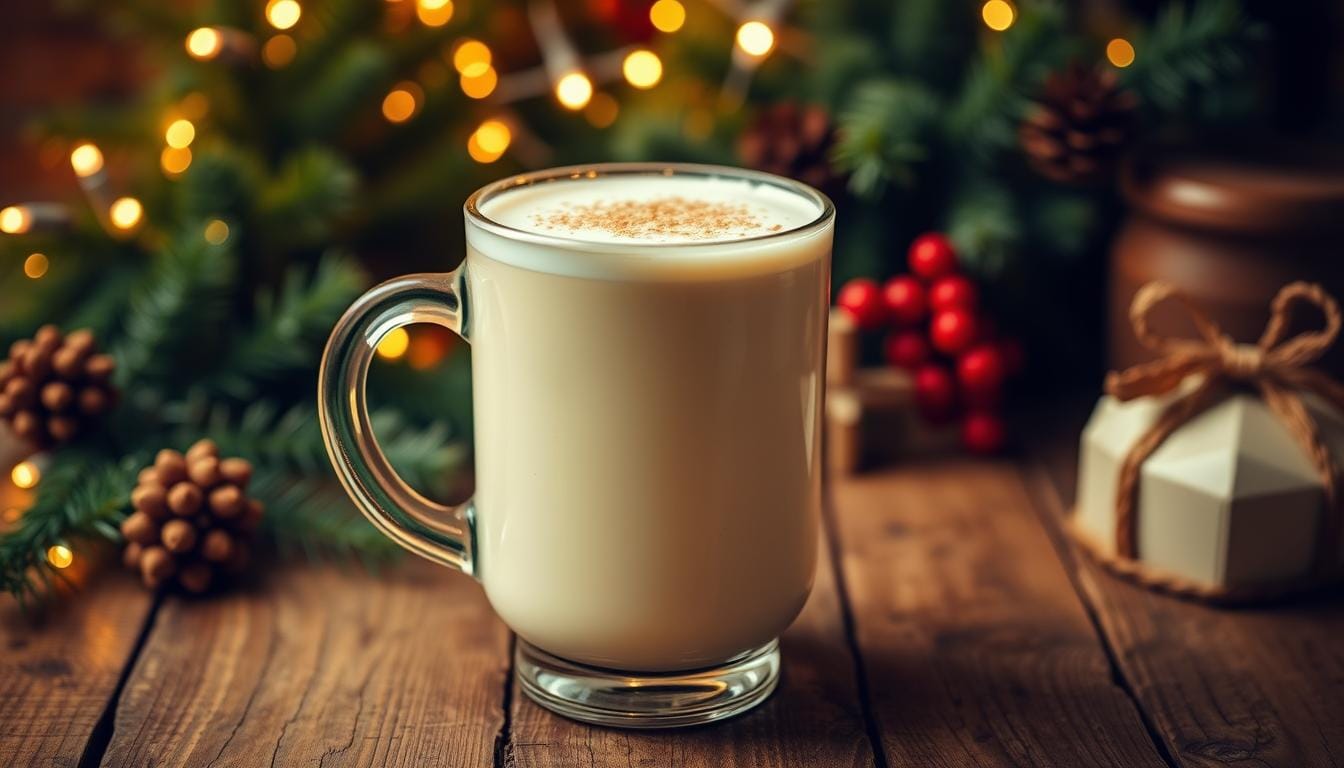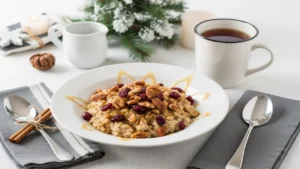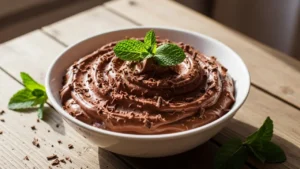There’s a smell that brings you back to family kitchens and quiet winter mornings. You remember stirring a warm, sweet mixture and sharing small glasses around the table. That memory is the heart of this guide.
You’ll learn how to make a thick creamy holiday drink that beats store-bought eggnog in freshness and foam. This recipe hinges on simple staples: milk, cream, sugar, eggs, and a touch of vanilla and nutmeg to lift the taste.
In the next sections you’ll see why separating components and controlling heat matters. You’ll also get tips for adding brandy, rum, or bourbon safely and for making a batch ahead so flavors deepen overnight.
Start here to swap the bottled stuff for a homemade eggnog recipe that delivers real flavor, better texture, and a festive finish your guests will remember.
Table of Contents

Thick & Creamy Homemade Eggnog
Equipment
- Whisk
- Mixing Bowls
- heavy-bottomed saucepan
- Measuring Cups
- fine grater (for nutmeg)
- thermometer (optional)
Ingredients
- 6 large eggs, separated
- ⅔ cup granulated sugar (divided)
- 2 cups whole milk
- 1 cup heavy cream
- 1 tsp pure vanilla extract
- ¼ tsp freshly grated nutmeg (plus more for garnish)
- ½ to 1 ½ cups rum, bourbon, or brandy (optional, to taste)
Instructions
- Separate 6 eggs. In a mixing bowl, whisk the yolks with 1/3 to 1/2 cup sugar until pale and creamy.
- In a saucepan, heat 2 cups milk and 1 cup cream until steaming but not boiling. Slowly temper the yolks by whisking in a small amount of hot milk mixture, then return all to the saucepan.
- Cook gently, stirring constantly, until the mixture thickens slightly and coats the back of a spoon (about 160°F). Remove from heat and cool completely.
- Once cooled, stir in vanilla, nutmeg, and optional alcohol to taste. Chill thoroughly for at least 4 hours or overnight.
- In a clean bowl, whip egg whites with remaining sugar (1/3 cup) until soft peaks form. Gently fold into the chilled base for a frothy texture.
- Serve cold with a sprinkle of nutmeg. Garnish with whipped cream and cinnamon stick if desired.
Notes
Nutrition
Why You’ll Love Making Eggnog at Home
Making holiday nog at home gives you control over every spoonful of flavor and texture. You craft the balance of milk and cream so the drink feels just right in your glass.
Fresh eggs create a light, frothy, custardy body that store-bought versions often miss. You can also skip commercial thickeners and rely on real dairy and technique for a cleaner taste.
Adjust sweetness with sugar and tweak spices like nutmeg and vanilla to suit your crowd. Make it boozy or keep it family-friendly—either way the flavor improves as it rests.
- Control milk-to-cream ratio for richness without heaviness.
- Pick your sugar level and fresh nutmeg for a brighter aroma.
- Make a batch ahead; eggnog made a day or up to a week ahead turns velvety.
- Scale from a nightcap to a party bowl while keeping consistent taste.
Ingredients and Tools for Thick, Creamy Homemade Eggnog
Begin with clear measurements and the best dairy you can find to craft a rich, balanced base. Lay out ingredients and tools so each step moves smoothly from prep to finish.
Core ingredients
You’ll gather milk, cream, sugar, egg yolks, and egg whites to build a custardy base and a frothy top. Vanilla and freshly grated nutmeg add the classic aroma you expect in this mixture.
Optional add-ins
- Choose rum, brandy, or bourbon for warmth. Add a splash to taste after chilling.
- Try cinnamon or a touch of maple syrup instead of white sugar for deeper color and flavor.
Essential tools
Keep a whisk and a heavy saucepan handy. Measure by the cup so ratios of milk and cream stay consistent.
Consider a thermometer if you’ll cook the egg yolk mixture to a safe temperature. Use a fine grater to shave fresh nutmeg just before serving for the brightest top note.
“Separate yolks and whites: yolks enrich the base while whipped whites lift the final pour.”
Step-by-Step: How to Make Eggnog You’ll Crave
This clear sequence keeps the process calm and reliable so you end with a thick, creamy holiday drink.
Whisk yolks and build the base
Separate 6 eggs for about six servings. Whisk egg yolks with 1/3 to 1 cup sugar together until pale and creamy. This creates the foundational egg mixture and gives sweet body to the cup.
Heat, temper, and cook the custard
Warm 3 cups dairy — for example, 2 cups whole milk and 1 cup heavy cream — until steaming but not boiling. Slowly temper eggs by adding a little hot milk to the yolks while whisking.
Return the combined mixture to the pot and cook gently until it coats the back of a spoon, then promptly remove heat. Cool completely before you add spirits so the alcohol stays vibrant.
Finish, chill, and fold in whites
After cooling, add rum or brandy to taste. Chill the base thoroughly so flavors marry.
Whip egg whites to soft peaks and fold them into the chilled mixture for a light, frothy top. Taste and add milk or cream to adjust viscosity.
- Use a thermometer or the “coats the back of a spoon” cue for safety.
- Rest overnight — up to a week — for the best texture; this technique has been used since December 2016 by many home cooks.
Egg Safety and Cooking Methods You Can Trust
Food safety should guide how you prepare and serve this classic holiday drink. You’ll choose a path that balances flavor and guest safety.

Using pasteurized eggs or cooking the base
Use commercial pasteurized eggs if you plan to serve people who are pregnant, elderly, or immunocompromised. That choice removes much of the risk tied to raw eggs.
If you prefer fresh eggs, cook the milk-and-egg mixture gently until it coats the back of a spoon. This cooked custard method sets the egg yolks and greatly reduces bacteria.
How alcohol and aging affect safety
Alcohol helps, but it is not a substitute for heat. A strong alcohol content plus cold storage lowers risk over time.
“Research shows added salmonella can persist about a week in a chilled, strong batch but may be gone within three weeks.”
To age safely, aim for roughly 20% ABV and keep the batch refrigerated. Label and date the container and discard any batch that smells off or separates oddly.
Practical serving rules
- If serving the same day, use pasteurized eggs or the cooked custard method.
- If you plan to age an alcohol eggnog, confirm ABV and refrigeration for several weeks before serving to others.
- Tell guests how you prepared the drink so they can choose what’s right for them.
Choose Your Spirit: Bourbon, Rum, Brandy, or Whiskey
Match your favorite brown spirit to the milk-and-egg mixture to shape the final flavor. The spirit you pick changes the aroma, warmth, and the way spices come through.
Bourbon for classic American warmth
Bourbon adds vanilla and caramel notes that melt into the creamy base. Use it when you want a familiar, cozy profile that pairs well with nutmeg and a touch of sugar.
Rum or spiced rum for colonial and Caribbean echoes
Choose light rum for subtle sweetness or spiced rum for molasses and clove tones. Colonial ports like New York favored rum historically, so this choice nods to tradition.
Brandy or cognac for silky depth
Brandy or cognac gives fruity, floral aromatics and a smooth finish. It shines when you want a refined, aromatic cup that lifts the spices.
Whiskey variations for a bold, winter-ready nog
Rye or blended whiskey adds spice and backbone. Use small amounts and taste as you go to keep the balance with milk and sugar.
How much alcohol to add—and when
- Add spirits only after the base cools so the character stays bright.
- Start modestly and aim up to about 1 1/2 cups per standard 6-egg batch, adjusting to taste.
- Consider blending two spirits—rum with brandy or a splash of whiskey—for complexity.
“George Washington mixed brandy, rye, rum, and sherry for a festive punch.”
Dairy-Free, Lighter, and Natural Sweetener Variations
You can keep the classic spice and body while choosing lighter or dairy-free milks for your holiday mix. This lets you enjoy a familiar cup without dairy, or simply make a lighter sip that still feels festive.
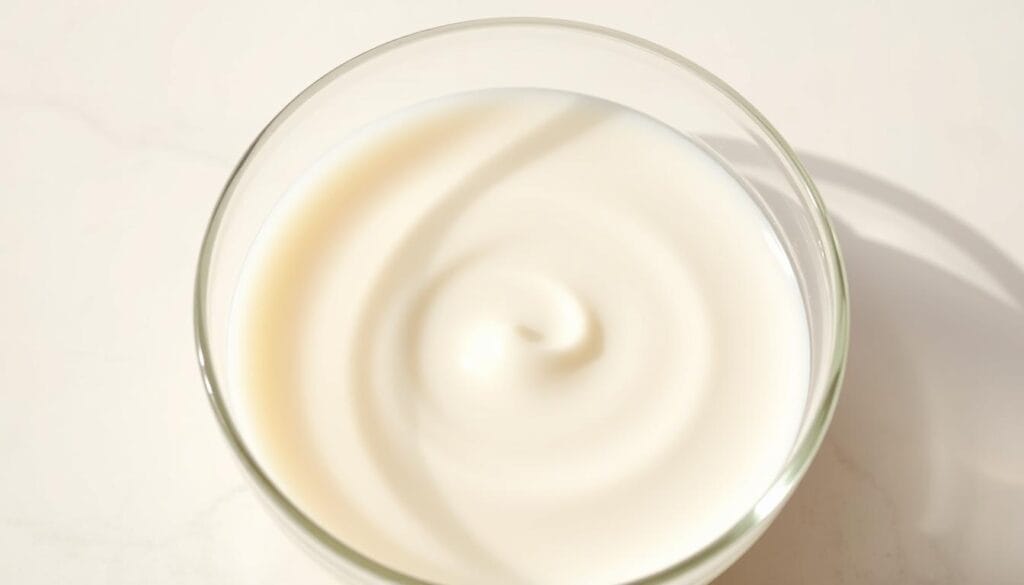
Coconut milk or coconut cream for rich, lactose-free results
Use full‑fat coconut milk or canned coconut cream to mimic the lush mouthfeel of milk and cream. Start with less, taste, and add more to reach the body you like.
Almond, oat, or rice milk for a lighter sip
Almond and oat milks give a thinner, nutty backdrop that lets spices and vanilla shine. Rice milk is the lightest option and works well if you want a gentler finish.
Sweeten with maple syrup, honey, or brown sugar
Swap refined sugar for maple syrup or brown sugar to add caramel and toffee notes. These sweeteners pair beautifully with nutmeg and a touch of vanilla.
- Decide whether to include eggs for a custardy base or skip them and thicken gently with your chosen non‑dairy.
- Adjust milk amounts in stages so the drink stays balanced.
- Whip aquafaba or a plant foam to recreate the frothy top if you want a vegan finish.
Serving Ideas: Cold and Frothy or Warm and Cozy
How you present the finished drink shapes the first impression—simple garnishes go a long way.
Chilled and festive
Serve chilled in glasses or snifters with a generous cloud of whipped cream and a fresh grating of nutmeg. Add a cinnamon stick for aroma and a classic look.
Stir the mixture gently before pouring to reincorporate any separation. If you folded in egg whites for froth, spoon a soft crown of foam on top.
Warm, hot milk punch vibes
Warm the base gently if you want a hot milk style cup. Heat slowly and stop before simmering so texture stays smooth.
Add alcohol—rum or brandy—only at serving. This keeps the spirit’s character bright and avoids cooking off the flavor.
If warming thickens the batch, add milk a little at a time until the body loosens to your liking.
| Service Style | Glassware | Garnish | Best Spirit |
|---|---|---|---|
| Chilled & Frothy | Glass, snifter, or cup | Whipped cream, grated nutmeg, cinnamon stick | Light rum or none (family-friendly) |
| Warm & Cozy | Mug or small punch cup | Grated cinnamon nutmeg, single cinnamon stick | Brandy or dark rum |
| Punch Bowl | Large bowl, ladle for self-serve | Floating cinnamon sticks, grated nutmeg | Rum and brandy blend |
- Keep toppings simple and refresh garnishes before each cup.
- Set modest pours so temperature and aroma stay balanced during service.
Eggnog
You’ll notice clear differences when you compare a homemade cup with a carton from the store. Homemade mixes use straightforward ingredients: milk, cream, sugar, egg yolks, and whipped egg whites for froth.
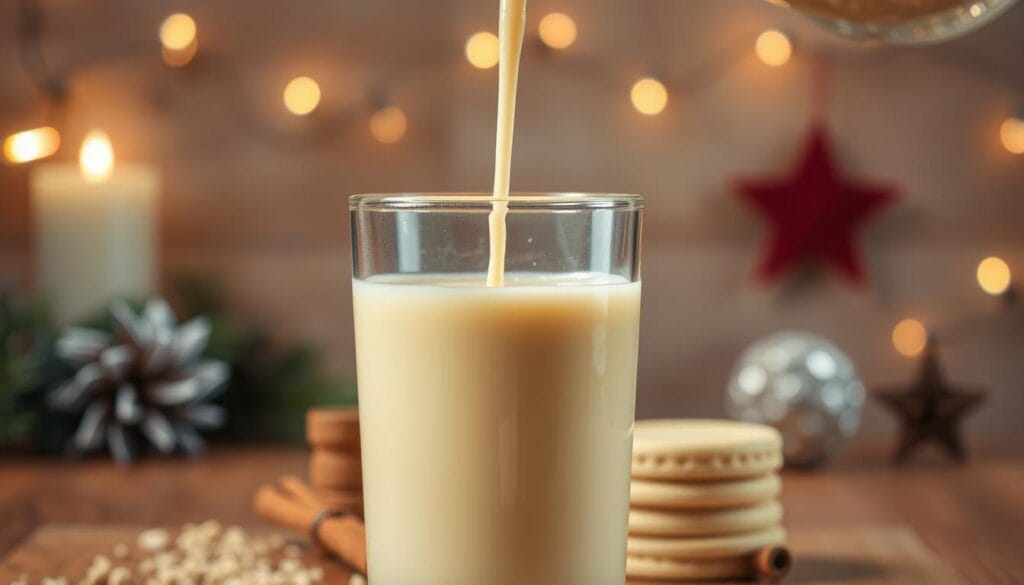
Homemade vs. store-bought: flavor, texture, and what’s in the carton
Store-bought eggnog often relies on thickeners like carrageenan or guar gum and can contain very little yolk solids. U.S. rules allow as little as 1% egg yolk solids in some products, while Canadian standards set minimum milk fat and solids.
Homemade eggnog delivers natural richness by tuning the milk-to-cream ratio. You control sugar and avoid the flat sweetness that condensed‑milk shortcuts can create.
Whipping egg whites gives a fresh, airy top that packaged versions rarely match. If you worry about raw eggs, use pasteurized eggs or cook the custard until it coats a spoon.
| Feature | Homemade | Store-bought |
|---|---|---|
| Main ingredients | Milk, cream, egg yolks, whipped whites, spices | Milk base, stabilizers, reduced egg solids, flavorings |
| Texture | Custardy, frothy, adjustable | Uniform, sometimes gummy |
| Sweetness control | Adjustable by cup | Fixed, often sweeter |
| Cost & convenience | More time, signature flavor | Cheap and quick |
“Regional traditions from New York to small kitchens shape what a proper egg nog should taste like.”
A Brief History of Nog: From Posset to Your Holiday Cup
The story of your holiday cup begins with a warm, spiced milk drink called posset. That medieval comfort evolved over centuries into a festive bowl in colonial America.
From British posset to a New World tradition
By 1693 the word “nog” appears in English usage, and by 1775 “egg-nogg” shows up in print. Colonists adapted posset, using local stores and trade goods to change the flavor.
Taxes on brandy and wine pushed many settlers toward Caribbean rum, especially through ports like New York. Rum became the common spirit, tying the drink to winter celebrations.
George Washington kept a lavish bowl in his household. His approach mixed brandy, rye whiskey, rum, and sherry with cream, milk, sugar, and eggs. He advised mixing liquor first, beating yolks and whites separately, and letting the mixture rest in a cool place while you taste it over days.
“Mix liquor first, beat yolks and whites separately, and let it rest in a cool place while tasting frequently.”
| Period | Region | Key shift | Note |
|---|---|---|---|
| Medieval | Britain | Posset: milk + wine/ale | Spiced, served hot |
| 18th c. | Colonial America / New York | Brandy → rum | Holiday staple for toasts |
| Late 1700s | United States | Eggs added for body | Written “egg-nogg” in print |
| 19th c. | U.S. towns | Hot variants (Tom and Jerry) | Warm, frothy winter drink |
Today, you connect that past to your modern recipe. Regional trade, high alcohol traditions, and family notes—updated as recently as December 2016—keep nog a living holiday custom.
Conclusion
Wrap the process up by trusting the simple steps that yield a smooth, frothy holiday cup.
Follow a reliable eggnog recipe: whisk egg yolks with sugar, heat milk and cream gently for a cooked base (or use pasteurized eggs), then cool before you add brandy, rum, or bourbon.
Chill so flavors meld, fold in whipped egg whites for lift, and garnish with grated nutmeg, cinnamon, or a touch of vanilla. Try maple syrup for nuanced sweetness or swap dairy for coconut or oat milk when desired.
You’ll leave with a clear homemade eggnog framework to make eggnog confidently, serve chilled or warm, and drink eggnog that reflects tradition and your own flavor choices.
FAQ
What are the core ingredients for a thick, creamy homemade eggnog?
Can you use pasteurized eggs or do you have to use raw eggs?
How do you temper egg yolks so they don’t scramble?
Which spirits work best and how much should you add?
What’s the difference between homemade and store-bought nog?
How far in advance can you make the mixture and how long does it last?
How do you make a dairy-free or lighter version?
Is it safe to add alcohol before chilling or should you add it right before serving?
Can you serve it warm, and how do you avoid losing alcohol when heating?
What tools do you need for reliable results?
How do you finish and garnish each cup for the best presentation?
Discover what’s cooking behind the scenes and beyond—find us on https://www.facebook.com/astrorecipes1.

